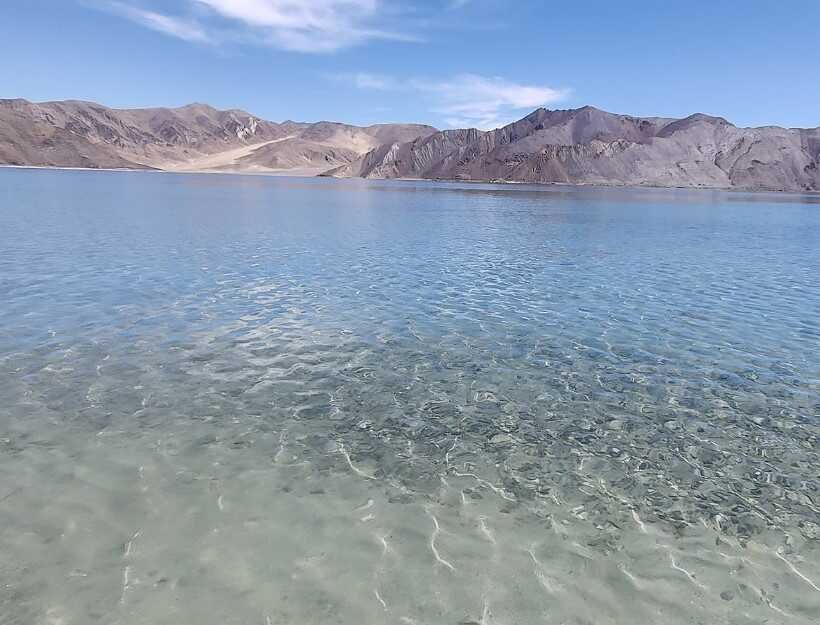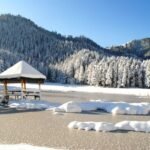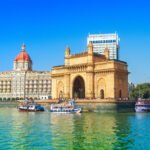How to Reach from Leh to Pangong Lake
Pangong Lake Overview:
Pangong Tso Lake, The Ecstatic Shades of Heaven in India: Pangong Tso Lake is the high altitude lake located in the border of Ladakh Region, India and Tibet, China. It’s a Tibetan name where “Pangong” means high grassland and “Tso” means lake and combined it’s called as High Grassland Lake. Located at a height of 14,270 feet above sea level on the Indo-China border, Pangong Tso is one of the world’s highest brackish water lakes.

It is popular for its stunning blue color but it constantly changes its color according to time and weather. Usually the lake is in blue color but around dusk and dawn the color changes to shades of orange and yellow. It also gives cyan shades some time if weather is appropriate. Many Indian movies like 3 Idiots, Jab Tak Hai Jaan and Dil Se have been shot here.
Pangong Lake Trip Guide:
Some Interesting facts about Pangong Tso Lake
- Geo-graphical Location
- It covers west Tibet and eastern Ladakh region.
- The lake is subdivided into five sub-lakes: Nyak Tso, Rum Tso (twin lakes), Tso Nyak, and Pangong Tso.
- Pangong Tso stretches for 134 kilometers (83 mi) with one-third of the lake in India and the remaining two-thirds in China. The eastern section of the lake is a disputed territory between the two countries.
- High Altitude & Salty Surprise:
- Pangong Tso sits at a staggering height of 4,350 meters (14,270 ft) making it one of the world’s highest saltwater lakes. Despite being saltwater, the lake freezes completely during the harsh winter months, creating a spectacular sight.
- A Multicolored Marvel:
- The lake’s name, “Pangong Tso,” translates to “high grassland lake” in Tibetan. But the most captivating aspect of the lake is its ever-changing colors. The water can appear blue, green, or even red depending on the sunlight, angle of observation, and mineral content.
- Barren But for the Birds
- Due to the brackish water, the lake has very little plant or animal life.
- However, it’s a haven for migratory birds, especially black-necked cranes and Brahmani ducks.
- Subdivided into five Sub-lakes
- Connected through narrow water bodies, Pangong Lake is made up of five sub-lakes.
- In Tibetan, these five lakes are referred to as Tsomo, Nganglha, Ringo.
- The name “Pangong Tso” was originally used for the westernmost lake, which lies mainly in Ladakh.
- The middle lake, the main one on the Tibetan side, is known as Tso Nyack.
- A Historical Landmark:
- The lake was once part of a much larger glacial system. Strandlines above the current water level reveal a thick layer of mud and sand, suggesting the lake has shrunk considerably over time.
- World’s Highest Saltwater Lake
- Pangong Tso is world’s saltwater lake.
- It reaches maximum depth of about 100m.
- Lake also famous for its changing colors like red, blue, green, cyan , orange depending on the weather conditions and tine.
Serene Beauty in Constantly Changing Colors
The White Colour
The color indicates purity, new beginnings, and fresh starts. It’s the absence of any color itself, because it reflects all the wavelengths of light that hit it.

The Blue Color
The blue color indicates tranquility and peacefulness. It also holds trust and evoke feelings of creativity and imagination.

The Cyan Color
Similar to blue, cyan can also symbolize calmness and tranquility due to its association with water.

The Red Color
The charm of Pangong lake is its ability to change color. Experts believe that change in sky color and refraction at high altitudes causes this phenomenon.

How to Reach Pangong Tso Lake form Ladakh:
How to Reach from Leh to Pangong Lake (around 171 km):
- Start your journey from Leh and head towards Spanmik, one of the halting villages near Leh.
- Follow this route: Leh – Karu – Sakti – Chang La – Tangste – Lukung – Spangmik.
- Along the way, you’ll have the chance to visit Hemis, Thiksey, and Shey monasteries1.
- The road is decently maintained, so you won’t face any major issues.
How to Reach From Nubra Valley to Pangong Lake (175 km):
Many travellers visit Pangong Lake after exploring Nubra Valley.There are two routes from Nubra valley:-
- Route 1
- (via Shyok Village): Diskit – Khalsar – Agham – Shyok Village – Durbuk – Tangste – Lukung – Spangmik.
- This route has a few waterlogs but offers an adventurous experience.
- Route 2
- (via Wari La Pass): Diskit – Khalsar – Tangyar – Wari La – Tathok – Chang La – Durbuk – Tangste – Lukung – Spangmik.
- The Wari La Pass route is more challenging and thrilling.
How to Reach From Delhi to Pangong Lake:
- Take regular flights to Leh from Delhi.
- After arriving in Leh, you can book a cab to Pangong Lake.
- Alternatively, tour providers can accompany you on the journey.
- Another option is the vehicle route: Delhi – Manali – Jispa – Darcha – Sarchu – Leh – Khardungla – Pangong.
Places to stay in Pangong Lake
Pangong Tso offers a unique stay experience, surrounded by mesmerizing beauty amidst high altitudes. Here are some options for places to stay, catering to different budgets and preferences:
- Luxuries Camps: There are lots of luxurious tented camps boasting stunning views of lake under the unforgettable experience under the stars.
- Mid Range Camps: These are comfortable and affordable for the travelers to use at Pangong Lake. These camps offer basic amenities like tents with bedding, and some may have shared bathrooms.
- Budget Camps: These are very affordable for the travelers because these camps offer basic amenities like shared tents and sleeping bags.
Here are some additional tips for choosing a place to stay in Pangong Tso:
- Consider the time of year you will be visiting. Some camps may be closed during the winter months.
- Think about the amenities that are important to you. Some camps offer amenities like hot showers and Wi-Fi, while others do not.
- Book your accommodation in advance, especially if you are traveling during peak season.
Best Time to Travel Pangong Tso Lake
The route to Pangong Tso is via the Chang La Pass, which is one of the highest motorable passes in the world, at an altitude of 5,360 meters. The road to the lake is open from May to September, and visitors should plan their trip accordingly.
The best time to visit Pangong Tso is during the summer months, from May to September, when the weather is pleasant, and the lake is accessible. The temperature during this time ranges from 15 to 25 degrees Celsius during the day, and it can get chilly at night. Lake freezes in winter and road to the lake closes during this time.
Visitors should also be prepared for the high altitude, and it is advisable to spend atleast two days in Leh to acclimatize before traveling to Pangong Tso. Altitude sickness is a common problem, and visitors should drink plenty of water and avoid strenuous activity to avoid any health problems.
Top 10 Things to do in Pangong Lake
- Camping at Pangong Tso: Camping at Pangong Tso is a thrilling activity that allows travelers to stay overnight near the enchanting lake. By camping at Pangong Tso, one has the unique chance to witness both the sunset and sunrise, which paint the mountains and the lake in hues of orange and gold.
- Pangong Lake Sightseeing: Pangong Lake is a marvel of nature situated at a high altitude in the Himalayas, known for its crystal-clear blue waters and pristine surroundings.
- Photography Expeditions: These expeditions c an be self-guided or led by professional photographers who assist participants in capturing the best shots while also teaching them about advanced photography techniques.
- Biking around Pangong Tso: Biking around Pangong Tso is a challenging yet rewarding experience that allows adrenaline junkies and cycling enthusiasts to explore the rugged terrain of Ladakh.
- Motorbike Tour: The journey typically starts from Leh, taking riders across challenging terrains, high-altitude mountain passes like Chang La, and through picturesque villages before reaching the iconic lake.
- Bird Watching: The tranquil experience allows bird enthusiasts to observe various species in their natural habitat. One can spot the Bar-headed Goose, Brahmini Ducks, and the rare Black-necked Crane among others. Visitors typically bring binoculars and cameras to capture the avian life. Guided tours are also available, where experts share information about the local bird species and their migratory patterns.
- Yoga and Meditation Retreats: Pangong Tso’s tranquil ambiance makes it an ideal destination for yoga and meditation retreats. Participants engage in rejuvenating yoga sessions by the lakeside, taking in the pristine air and soaking up the peaceful vibes of the location.
- Kayaking and Canoeing: While relatively rare due to the lake’s high altitude and cold temperatures, kayaking and canoeing are possible activities at Pangong Tso for those looking for an aquatic adventure. It is an activity best suited for those who are accustomed to high altitudes and cold weather.
- Local Homestay and Cultural Influences: Staying at a local homestay near Pangong Tso is an enriching activity, offering deep cultural immersion. Visitors get to experience the hospitality and daily life of the Ladakhi people by living with a family in their home. Such stays often include sharing meals with the host family, prepared using traditional cooking methods, and include local ingredients and recipes.
- Changthang Wildlife Sanctuary: Trekking in the nearby Changthang Wildlife Sanctuary offers an unparalleled adventure for wildlife and nature enthusiasts. A guided trek can lead travelers through diverse landscapes, ranging from high-altitude wetlands to rugged, barren terrain. A trek in this sanctuary, with Pangong Tso as a highlight or a starting point, often includes overnight camping under the stars.
Pangong lake weather
Pangong Lake experiences dramatic weather changes throughout the year. Here’s a general overview:
- Summer (June – August): Considered the best time to visit. Days are pleasant with highs around 40°C (104°F), but nights can get chilly, dropping down to 5°C (41°F).
- Spring (April – May): Pleasant temperatures range between 15°C and 20°C (59°F and 68°F) during the day. Occasional snowfall might occur at higher altitudes.
- Autumn (September – October): Temperatures start dropping, making the days moderately cold. Expect highs around -2°C (28°F) and lows even colder.
- Winter (November – March): Pangong Lake becomes freezing cold. Temperatures can plummet to -25°C (-13°F) with occasional snowfall, making the area inaccessible for tourism.
Follow Us on Facebook Page
Where is Pangong Tso Lake located?
Pangong Tso Lake, the world’s highest saltwater lake, is located in Ladakh at an elevation of almost 4,350 m.
What is the depth of Pangong Lake?
Around 328 feet or 100m is the depth of Pangong lake.
Why is Pangong Lake Blue?
Pangong Lake appears blue due to the reflection of the clear sky and surrounding mountains on its surface. The lake’s blue color is a result of the scattering of sunlight by fine particles and dissolved minerals suspended in its waters, giving it its distinctive azure hue.
Why Pangong lake is salty?
Pangong Lake’s salinity is due to its closed drainage system. Unlike lakes that flow into rivers and eventually reach the ocean, Pangong Lake has no outlet. This means any minerals and salts that dissolve from the surrounding rocks accumulate in the lake over time, making it saltier.
Can I visit the Pangong Lake during winters?
Well, Yes! The lake gets completely frozen with thick surface at the top during winters and is a worth to look at. The only issue you may face is blockage of roads due to snowfall. But you can still reach here by catching flight to Leh and travel with the help of locals or army or hire a safe vehicle which you are expert at to reach Pangong.
Why is Pangong Lake so famous?
Due to world’s highest saltwater lake.
What does “Pangong Tso” mean?
Pangong Tso comes from the Tibetan words “Pangong” which means “bright, spacious, long,” and “Tso” which means “lake.” So, Pangong Tso translates to “high and long saltwater lake”.
What is the best time to visit Pangong Tso?
The best time to visit Pangong Tso is generally between May and September.
Do I need a permit to visit Pangong Tso?
Yes, a permit is required to visit Pangong Tso since it is located in a sensitive border area.
What type of permit do I need?
Indian citizens need an Inner Line Permit (ILP) to visit Pangong Lake. Foreigners (except for Bhutanese citizens) require a Protected Area Permit (PAP). Permits can now be obtained online, but foreigners may need to use a registered travel agent in Leh, particularly if traveling solo.
Where can I stay near Pangong Tso Lake?
There are a number of guesthouses and camps located near Pangong Tso. These are basic accommodations, but they offer a unique opportunity to experience the beauty of the lake at night.















